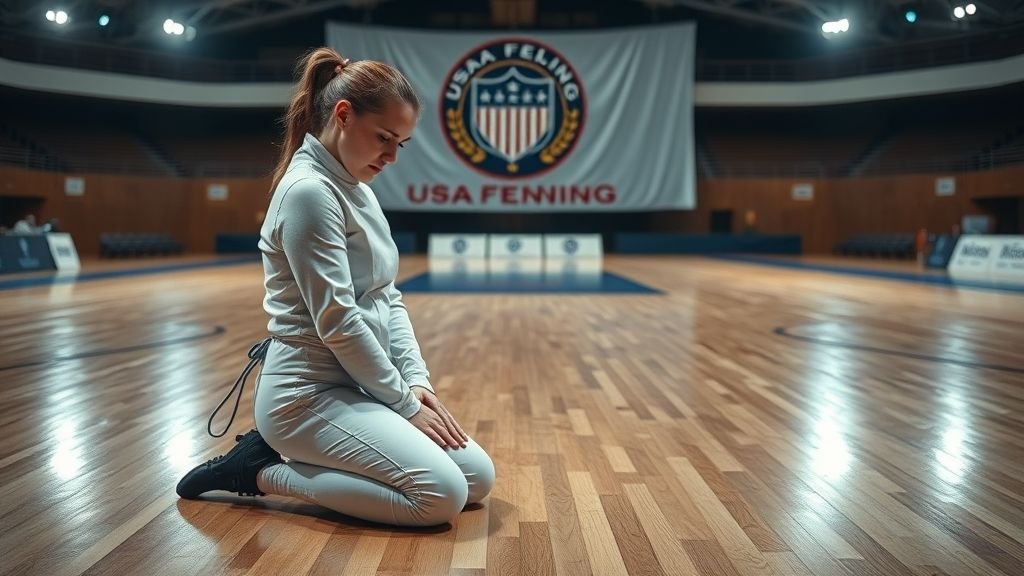Introduction
A women’s fencing pioneer, who gained fame by kneeling during a match to oppose policies affecting trans athletes, has responded to a major shift in the sport’s rules. Recently, USA Fencing announced it would change its previously strict policies for trans inclusion. This move has sparked a wave of applause from some and criticism from others. The debate touches on a larger question: How do sports balance fairness with the goal of allowing all athletes to compete? It’s a hot topic not just in fencing but across many sports today.
The Background of the Protest and the Controversial Policies
Historical Context of Trans Inclusion in Fencing
USA Fencing has long been trying to find the right way to include transgender athletes. Several years ago, the organization introduced policies meant to make the sport more welcoming. These policies aimed to give trans women and men fair chances but also raised concerns about safety and fairness. Critics argued that some policies favored trans athletes over cisgender competitors, especially women.
Before the protest, debates heated up. Some athletes, coaches, and fans felt that the rules weren’t consistent or fair. As discussions spread nationwide, politics played a big role. Trans rights became a bigger issue in sports, leading to calls for stricter or more relaxed policies. This tension set the stage for athletes to take action.
The Protest by the Women’s Fencer: Motivations and Actions
The protest involved a female fencer kneeling during a match, holding a sign that called for fair treatment for all athletes. Her act was inspired by her belief that current policies weren’t just confusing but hurt women’s sports. She later explained that she wanted to send a strong message about fairness and safety. Her action gained attention quickly, sparking both support and criticism.
Many in her community praised her courage. Others thought she should leave politics out of sports. But she stood firm, making it clear her protest was about protecting women’s rights to compete on a fair playing field. The immediate reactions showed how divided opinions are on this topic.
Broader Social and Political Climate

This protest is part of a bigger conversation happening across the country. Gender issues have become central in many areas, especially in sports. Politicians and activists often clash over what is fair and what isn’t. Some push for more inclusion; others want stricter rules to preserve fairness. These debates influence policies in many sports organizations, not just fencing.
The social climate today waters down to questions like: Should anyone who identifies as a woman be allowed to compete as a woman? Or does that threaten fairness for others? These questions are difficult but necessary to ask if we want sports to be truly inclusive and fair.
The Reversal of Policies by USA Fencing: What Changed?
Details of the Policy Reversal
USA Fencing’s original policies set strict rules for trans athletes, like hormone levels and physical criteria. But they recently announced they will change these rules, making the process clearer and more flexible. The new policies focus on individual assessments, rather than blanket bans or strict cut-offs.
In their official statement, USA Fencing explained that these changes aim to balance inclusion with fairness. They emphasized respect for all athletes’ rights while prioritizing safety and integrity. Many in the fencing world see this as a step in the right direction.
Stakeholder Reactions
The policy change drew mixed reactions. Many athletes and advocacy groups welcomed the move, saying it shows growth and understanding. They believe the new policies better reflect today’s values. On the other hand, some critics remain suspicious, arguing the changes could still threaten fairness.
Politicians opposing trans rights also weighed in, claiming that safety and fairness might be compromised. The fencing community feels a lot of pressure to adapt, but many hope this is the start of more open discussion.
Impact on the Fencing Community
This reversal could have ripple effects. It may encourage other sports to revisit their policies, possibly leading to more inclusive rules. Club organizers and officials are also watching closely, knowing that what happens here can set a precedent. The goal is to develop policies that everyone can accept, without sacrificing fairness or safety.
The Women’s Fencer’s Reaction and Perspectives
Personal Statement and Public Response
After hearing about the policy reversal, the original protester shared her thoughts publicly. She said she was glad to see USA Fencing reconsider its previous stance. But she also added that she remains cautious. She hopes the new rules will truly protect all women’s rights and fairness. Her message is clear: activism doesn’t end just because a policy changes.
Supporters of her protest saw her reaction as validation of her message. They believe her actions helped push the conversation forward. Critics, meanwhile, think she should focus more on sportsmanship. Still, her stand keeps the spotlight on the need for continuous dialogue.
The Significance of Her Protest in the Context of Athlete Activism
Her kneeling wasn’t just about one match; it was a call for change. It showcased how individual athletes can speak out against policies they see as unjust. That act of protest ignited a bigger conversation that forced governing bodies to think twice. Her story proves that one voice can challenge large organizations and influence policy shifts.
Experts agree her actions added weight to the debate. They see her protest as a symbol of how athletes today aren’t afraid to stand up for what they believe is right. This kind of activism often drives change, even when it’s uncomfortable.
Expert Opinions on the Protest and Policy Change
Sports ethicists say protests like hers highlight important questions about rights and fairness. Some argue that respecting athletes’ identities should be a priority. Others worry about how to balance inclusion with safety.
Gender studies scholars suggest this debate isn’t just about rules but about societal values. Fencing officials see the change as a positive step, but emphasize the need for ongoing review. Her protest helped open this conversation for good.
Broader Implications for Gender Inclusion and Fairness in Sport
The Balance Between Inclusion and Fair Competition
Deciding who can compete as a woman is complicated. Some say policies should prioritize inclusion, making sports welcoming for everyone. Others say that fairness and safety must come first. Data shows that trans women’s participation does raise questions about physical advantages, but solutions are still being tested.
The challenge is to find rules that embrace diversity without hurting others’ chances. More research is needed, but one thing’s clear: No one-size-fits-all solution exists.
Lessons for Sports Organizations
Sports groups can learn from this situation. The best policies are transparent, consistent, and shaped by dialogue. Listening to athletes’ voices and experts creates trust. Organizations should implement clear assessment processes and allow appeals to avoid unfair mistakes.
Equal respect and open communication are key. Organizations that foster inclusive conversations are more likely to craft fair rules everyone can accept.
Actionable Tips for Advocates and Athletes
Athletes wanting to stand up peacefully can:
- Use social media to share their views respectfully.
- Join or create advocacy groups that promote fair policies.
- Engage in open discussions with organizers and officials.
- Support policies that balance inclusion with safety.
Organizations should:
- Regularly review and update policies.
- Include athlete voices in decision-making.
- Promote transparency and understanding.
- Educate members about gender issues in sports.
Conclusion
The story of a women’s fencer kneeling in protest and the subsequent policy reversal shows how powerful individual actions can be. It reminds us that sports aren’t just about winning—they’re about fairness, respect, and inclusion. While the debate continues, ongoing dialogue and careful policy-making are essential.
Respectful conversations and regular updates based on science and ethics will help lead us to a future where everyone can compete fairly and confidently. As sports evolve, so should our understanding of what true inclusion really means. Keep pushing for fairness, and never underestimate the power of one voice to inspire change.
